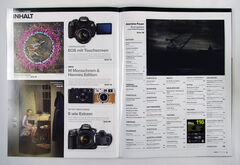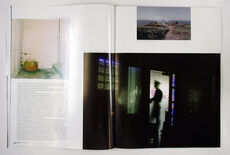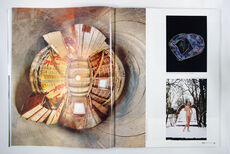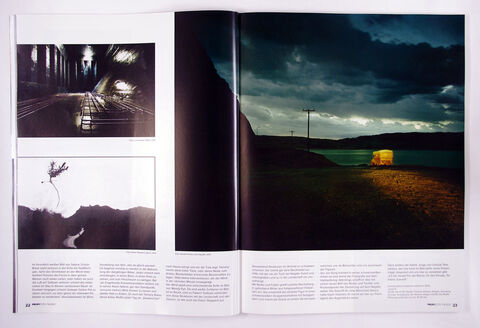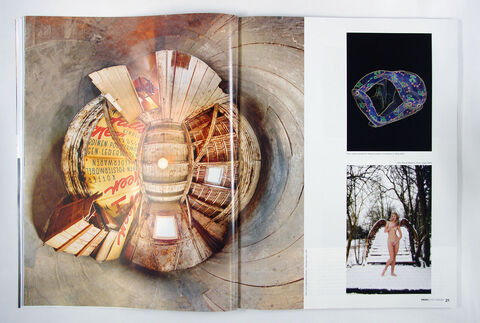Profifoto Nr. 7 2012 (dt.)
photographers:network
selection 2012
„visions“
Anfang 2012 habe ich wieder Kollegen und Freunde weltweit eingeladen, die ich im Laufe der letzten Jahre kennen gelernt habe, an diesem Projekt teilzunehmen. Dieses Mal mit Absicht eher diejenigen, die ich nicht bei Amerikanischen Festivals kennengelernt habe, einzuladen, da mir in den vergangenen Jahren die Amerikanischen Kollegen zu dominierend wurden. Es sind allesamt meist junge Kollegen, die ich bei Festivals, auf den Kunstmessen und in meinen Galerien oder bei Ausstellungen kennen gelernt habe. Mit manchem von ihnen verbinden sich bereits auch schon jahrelange Freundschaften. 2012 haben sich knapp 100 Fotografen aus 22 Ländern beworben, darunter aus: Belgien, Brasilien, Kanada, der Schweiz, Tschechien, Deutschland, Spanien, Frankreich, Griechenland, Israel, Indien, Italien, Neu Seeland, Polen, China, Portugal, Russland, Schweden, den Vereinigten Arabischen Emiraten, Großbritannien und den USA.
Ziel des Projektes ist es ein Netzwerk unter Kollegen aufzubauen und sich gegenseitig zu fördern. Eine sachkompetente Jury aus zwei Journalisten (Thomas Gerwers, PROFIFOTO und Manfred Zollner, fotomagazin), einer New Yorker Galeristin (Debra Klomp Ching ) und zwei Kuratorinnen (Peggy Sue Amison, Sirius Arts Center, Cobh, Irland und Barbara Tannenbaum, Cleveland Museum of Art, Cleveland, USA) haben gemeinsam mit mir die 18 auszustellenden Arbeiten ausgewählt, einen Portfoliopreis vergeben und eine Einzelausstellung (Art Galerie Siegen) nominiert. Der Journalist hat einen anderen Blickwinkel, als der Galerist, oder der Kunsthistoriker, oder ich als freischaffender Künstler und so entsteht jedes Jahr mit teils wechselnder Jury eine neue Auswahl.
Die Ausstellung zeigt kein bestimmtes Thema, auch wenn sich Überschneidungen mit meinen eigenen Interessen oder denen der anderen untereinander ergeben. Die ausgestellten Arbeiten zeigen die Vielfalt fotografischer Ansätze, die zeitgleich mit meinen eigenen Arbeiten entstehen. Für das kommende Jahr deutet sich bereits eine Gesamtschau an, auf die ich selber sehr gespannt bin. Die meisten Kollegen traf ich im vergangen Jahren bei verschiedenen Portfoliosichtung. Die 18 ausgewählten Fotografinnen stammen aus 13 verschiedenen Ländern aus Nordamerika, Europa, Indien und Neuseeland. Die meisten der Kolleginnen und Kollegen lernte ich bei rhubarb-rhubarb in Birmingham kennen, aber auch beim Fotofestiwal in Lodz, Polen, Fotoarte Brasilia, FotoBild Berlin und der vfg im schweizerischen Zürich.
In jedem Jahr kommen durch die unabhängige Auswahl von verschiedenen Juroren aus unterschiedlichen Verwertungszusammenhängen der Fotografie unerwartete Gruppenausstellungen zustande. In diesem Jahr hatte ich Wert auf eine paritätisch besetzte Jury gelegt, um der immerwährenden männlichen Dominanz in der Jury entgegenzuwirken. Und wie der Zufall es will, so sind auch die Teilnehmerinnen und Teilnehmer dieses mal gleich verteilt. Die Auswahl ist mehr oder minder zufällig, da auch die Fotografen von mir nicht gebeten werden etwas bestimmtes einzureichen. Jeder Juror wählt für sich aus und mir obliegt das zusammenführen der Ergebnisse und im Zweifelsfalle das Zünglein an der Waage zu sein.
Von Beginn des Projektes an, ergab sich bei der Betrachtung der ausgewählten Bilder ein zentraler Begriff, eine fast magische manchmal sehr schnelle Assoziation: Dieses Mal war der Gesamteindruck erst diffus, machte mich gar nervös. Sehr schnell bildet dieser erste visuell emotionale Eindruck Wörter, Begriffe, Zusammenhänge, auch manches, das sich schwerlich in Worte fassen lässt. Und trotzdem steht am Ende dieser Betrachtung meist nur ein Wort. „visions“.
Allesamt verbindet eine bestimmte visionäre Kraft. Ob es die Komposition ist, der Eingriff in den Bildbestand, oder die Vorstellungskraft etwas bestimmtes visuell zu verbinden, immer scheint dieser Moment der Vision doch der Tragende zu sein.
Herausfordernd schaut uns so manche Figur entgegen. Einen kleinen Augenblick braucht es bis man in dem Akt von Pascal Baetens den Engel erkennt. Wir folgen der Vorstellungskraft die Pascal bei seiner Aufnahme hatte und schaffen es tatsächlich über den Akt hinaus auf den Engel zu schauen. Dem Blick des jungen Mannes von Marco Citron ist kaum auszuweichen, entlarvt er doch eher den Betrachter selber der gerade hinschaut. Was willst Du? So ähnlich scheint sich auch die Figur bei Ursula Sokolowska herumzudrehen. Dort dachte ich im ersten Moment es sei ein Kind, bei genauerem Hinsehen entdecke ich aber die Projektion eines Gesichtes auf eine Puppe. Der Fernseher zeigt keinen Film mehr, blauer Schnee flimmert dort und die Puppe scheint die Luft anzuhalten. Mir selbst stockt lächelnd der Atem.
Im freundlich weißen Bild von Sabine Schulz-Blank steht verloren in der Ecke ein Goldfischglas. Geht das Stromkabel an der Wand etwa zu dem Goldfischglas? Können die Fische in dem grünen Wasser noch etwas sehen oder halten sie auch die Luft an? Seltsam verloren scheint das letzte Leben im Glas in diesem verlassenen Raum. Im Dunkeln hingegen schein Undayar Sankar Pal zu sitzen und sich vor dem gleich hintreitenden Polizisten zu verstecken. Verschwommen ist diese Vortsellung von dem, was da gleich passiert.
Ich beginne unruhig zu werden in der Betrachtung der diesjährigen Bilder. Jedes scheint mich einzufangen, in einen Bann, in einen Kreis zu ziehen, und zum Hinschauen zu zwingen. Bei Jan Engelhardts Kreisinterpretation verliere ich in seinen raum fallend gar den Standpunkt, versuche meinen Blick kreisen zu lassen und wieder Halt zu finden. So auch bei Tamany Baker, deren Katze Wolfie jeden Tag ein „Dankeschön“ nach Hause bringt und vor die Türe legt. Tamany nimmt diese toten Tiere, oder deren Reste zum Anlass Blumenbilder, kreisrunde Blumenaltäre zu legen. Stille kleine Interventionen, die der Wind in der nächsten Minute hinweg trägt.
Der Wind spielt eine entscheidende Rolle im Bild von Wendy Pye. Da sind weiße Schlieren im Bild. Ist es Rauch, sind es Fäden? Seltsam verbinden sich diese weißen Strukturen mit der Landschaft und den Zäunen, wie auch bei Diane Stoppard aus Neuseeland Strukturen im Himmel zu schweben scheinen. Sie nimmt gar eine Stecknadel zur Hilfe mit der sie ein Tuch am Negativ fixiert und mit vergrößert und so in der Landschaft vor uns aufhängt.
Mit Nadel und Faden greift Ludmila Steckelberg in gefundene Bilder aus fortgeworfenen Fotoalben ein. Sie umwickelt die zentrale Figur in einer schwarzweißen Gruppenaufnahme mit farbigen Garn und macht die Szene zu einem Verwirrspiel zwischen uns als Betrachter und uns selbst anschauender Figuren.
Qiu Jun Sung erinnert in seiner schwarzweißen Vision an eine Inkunabel der Fotografie aus dem Vietnamkrieg. Allerdings schafft er dies mit einem neuen Bild von Mutter und Tochter und Prozessspuren der Zerstörung auf dem Negativ selber. Die Zukunft für viele Menschen Asiens hatte kaum Visionen. Er macht sie hier zur Flüchtigkeit des Augenblicks selber.
Ganz anders der kleine Junge von Ursula Tarasiewicz, der hier keck im Bild steht, seine Hosenträger abspreizt und uns klar zu verstehen gibt: Ich bin bereit! Für die Bühne, für den Einsatz, für meine Zukunft.
photographers:network selection 2012
"hope"
23.Juni bis 1.Juli
Studio Thomas Kellner
Siegen, Germany
Ursula Tarasiewicz, Art Galerie Siegen 24.06. – 15.09.2012
Profifoto Nr. 7 2012 (en.)
photographers:network
selection 2012
"Visions"
photographers:network
selection 2012
"Visions"
At the beginning of 2012, I invited colleagues and friends whom I have met during the past few years from around the world to participate in this project again. This time I purposefully invited those that I had not met at any American festivals, since in the past years the amount of American colleagues tended to prevail. Most of them are young fellow artists, whom I have met at festivals, art fairs, exhibitions and in my galleries. To some of them, I have been connected through years of friendship. In 2012, almost 100 photographers from 22 countries submitted their applications, among them: Belgium, Brazil, Canada, Switzerland, the Czech Republic, Germany, Spain, France, Greece, Israel, India, Italy, New Zealand, Poland, China, Portugal, Russia, Sweden, the United Arab Emirates, Great Britain and the United States.
The goal of the project is to build up a network among colleagues and to promote each other. An expert jury composed of two journalists (Thomas Gerwers, PROFIFOTO and Manfred Zollner, fotomagazin), a New York gallery owner (Debra Klomp Ching) along with two curators (Peggy Sue Amison, Sirius Arts Center, Cobh, Ireland and Barbara Tannenbaum, Cleveland Museum of Art, Cleveland, Ohio) along with me have selected 18 projects for exhibition, awarded a portfolio prize and nominated the solo exhibition (Art Galerie Siegen). Since a journalist has a different point of view compared to the gallery owner, the art historian or me as a freelance artist, a new selection is made through a partly changing jury every year.
The theme is not dedicated to a specific subject even if there are overlaps with my personal interests or those of the other jury members. The works on exhibition demonstrate the variety of photographic approaches, which develop at the same time as my own works. The coming year means years of sifting through different portfolios. The 18 women photographers selected stem from 13 different countries in North America, Europe, India and New Zealand. Most of the artists I met at rhubarb-rhubarb in Birmingham, England, but also at the Fotofestiwal in Lodz, Poland; Fotoarte Brasilia; FotoBild Berlin and the vfg in Zurich.
Through the independent selection of different jury members, who all have various business motives in photography, unexpected group exhibitions develop every year. This year, I focused on a jury with equal representation, to counterbalance the everlasting male dominance there. And as chance would have it, this time the participants have as well been distributed equally. The selection is more or less by coincidence, since also the photographers have not been asked to submit work on a specific subject. Each jury member chose on their own and it was my job to merge the results and to sometimes tip the scale when necessary.
From the very start of the project, there was a central theme when looking at the selected images, an almost magical, sometimes even very quick association. This time the general impression was at first vague, it even made me nervous. Very quickly though, this initially emotional impression led to words, expressions, connections, but some were also difficult to formulate. But in spite of everything, at the end of the viewing, it all led to one word: "Visions".
Each and every image is connected with a certain visionary strength. Whether it is the composition, the intervention into the image or whether the imagination connects something in the eye - this moment of the vision seems to be the carrying element.
Some figures challenge us by the way they look at us. It takes a moment before we recognize the angel in Pascal Baetens' nude. We follow the image that Pascal had in his mind when he made the image and our eye actually manages to leave the nude scene and look up to the angel. In Marco Citron's image, the young man's gaze can hardly be ignored. It is more as if the viewer is being exposed at that moment. What do you want? This is similar to how the figure in Ursula Sokolowska's picture turns around. At first, I thought it was a child, but then looking closer, I discover the projection of a face on a doll. There no longer is a film running on the television, blue snow flickers there and it seems as if the doll is holding its breath. I myself hold my breath with a smile.
In Sabine Schulz-Blank's invitingly white image, there is a goldfish jar standing lost in the corner. Does the electric cable on the wall lead to the goldfish jar? Can the fish in the green water still see something or are they holding their breath too? The last life in a jar seems strangely lost in this deserted room. In contrast, Undayar Sankar Pal seems to sit in the dark and hides from the policeman who is about to enter the room. The idea of what is about to happen there is vague.
I begin to grow uncomfortable while gazing at this year's images. Each one seems to capture me in a spell, to pull me into a circle and to force me to look. In Jan Engelhardt's interpretation of circles, I lose my stance while falling into his space. I try to let my eye go around and then regain my balance. The same applies to Tamany Baker, whose cat, Wolfie, brings home a "thank-you" every day and places it in front of the door. Tamany uses these dead animals to create flower pictures with their remains, to lay them out in round flower altars. Still, quiet interventions, which in the next minute disappear in the wind.
The wind plays a decisive role in Wendy Pye's picture. There are white streaks in the image. Is it smoke, or are they threads? These white lines connect themselves strangely to the landscape and the fences as in the New Zealand artist's image, Diane Stoppard, structures seem to float in the sky. She even uses a pin to attach a piece of cloth to a negative, then enlarges it and hangs it up in the landscape in front of us.
Ludmila Steckelberg uses needle and thread in pictures she found in thrown-away photo albums. She winds colored thread around the central figure in a black and white group portrait and thus creates a puzzle between us the viewer and as figures looking at ourselves.
Qiu Jun Sung reminds us of a photographic incunable in his black-and-white image from the Vietnam War. However, he does create a new image of mother and daughter and the traces of the deterioration process on the negative itself. The future for many people in Asia held hardly any visions. Here, he creates it for himself for a fleeting moment.
The little boy pulling away his suspenders in Ursula Tarasiewicz's photograph is quite different and seems to make it absolutely clear to us: I am ready - for the stage, for the performance, for my future!
photographers:network selection 2012
"visions"
June 23 to July 1
Thomas Kellner Studio
Siegen, Germany
Ursula Tarasiewicz, Art Galerie Siegen June 24 - September 15 2012

